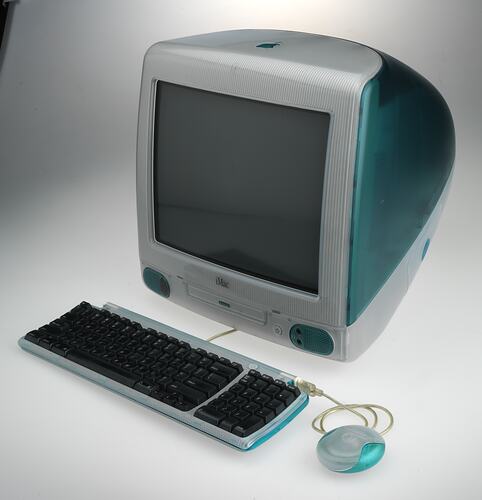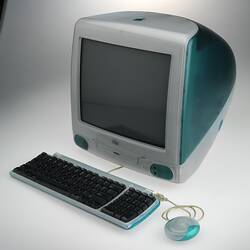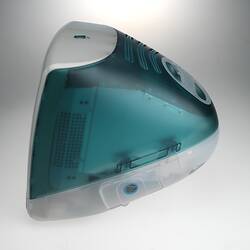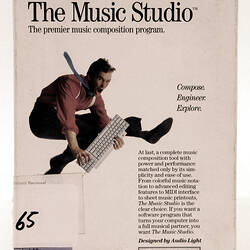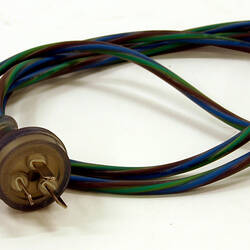Summary
Apple iMac, introduced in August 1998 and discontinued in January 1999. This first model iMac was known as the Bondi Blue iMac. It is accompanied by a keyboard incorporating numeric pad, round mouse and a power chord.
The iMac included software that enabled an uninitiated person to immediately access the internet. It was the first all-in-one box to incorporate a modem. It also marked a watershed in industrial design development because of the use of modern coloured transparent plastics to achieve the all-in-one concept.
With its curved lines and blue colour, the iMac was a major step away from the "beige box" that was the computer industry standard design. Aesthetically, the iMac was dramatically different from any other mainstream computer ever released. It was made of translucent "Bondi blue"-coloured plastic, and was egg-shaped around a 15-inch (38 cm) screen. There was a handle, and the computer interfaces were hidden behind a door that opened on the right-hand side of the machine.
Attention was given to the out-of-box experience: the user needed to go through only two steps to set up and connect to the Internet. The various components were colour co-ordinated and lent themselves to the personalising of personal work spaces for example, with stationery, lamps and desk caddies. The keyboard, mouse and power cord were made from a translucent material - a marketing ploy to make consumers feel that the items were 'honest'.
The period 1998 onwards saw a renewed emphasis on industrial design and the iMac was the first product to evidence this renewal. While returning to the all in one design of the original Mac, it shocked the PC industry by what it left out as much as what it included.
Since the early 1980s, desktop computers were fitted with built-in disk drives. The iMac was the first computer not to have a built-in floppy disk drive.
USB connections were adopted. Including USB as the only means of connecting peripherals saw an explosion of new devices which used this connection, which had been designed initially for the IBM clones, but had been left languishing through disuse. By using USB connections, peripherals such as digital cameras, scanners and printers became part of what Jobs terms the Digital Hub concept, with the computer acting as a central connecting device for a variety of digital peripherals.
Apple declared the "i" in iMac to stand for "Internet" and a naming fad of words starting with 'i' commenced.
The names given by Apple to the colours of the first iMac were Bondi Blue and Ice. The Bondi Blue colour is said to have been based on the deep blue colour of the water at Bondi beach, a popular surf beach at the Sydney suburb of Bondi. There is an interesting parallel between surfing at Bondi Beach and 'surfing' the web with the iMac's in-built modem.
The donor regarded the iMac as a very exciting piece of technology to own, and still has a very warm affection for its beautiful, smart and compact shape, and for the possibilities that it generates. She says that it appeals as a piece of art rather than a piece of technology.
Part of a representative collection of hardware, software, trade literature and promotional material that documents the history of the Apple company, and its contribution to, and impact on the computer industry and society.
Physical Description
Computer console Keyboard Mouse Power cord
More Information
-
Collection Names
The Apple Company Collection, Internet Macintosh User Group (iMug) Collection
-
Collecting Areas
-
Acquisition Information
Donation from Ms Lecki Ord, Mr Ian Godfrey, 22 Nov 2006
-
Manufacturer
Apple Computer Inc, Cupertino, California, United States of America, 1998
-
Inscriptions
'iMac' is written below the screen of the computer console
-
Brand Names
-
Classification
-
Category
-
Discipline
-
Type of item
-
References
Website accessed 15 Dec 2009: [Link 1]
-
Keywords
Computer Networking, Computers, Computing, Desktop Computers, Making History - Apple Computer Collection, Innovation & Design
